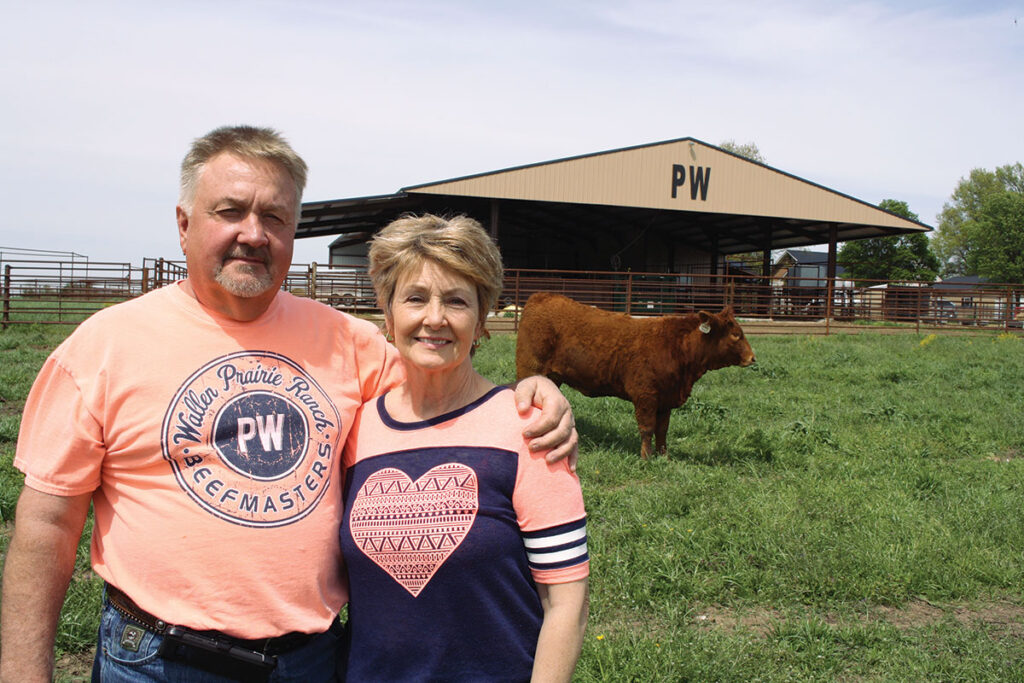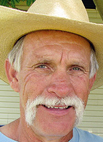
Wallen Prairie Ranch, and Paul and Rhonda Wallen strive for the best Beefmaster cattle possible
Paul Wallen and his wife Rhonda took a big risk in 2006, a risk that paid off.
“We started with registered Beefmaster seedstock in 2006. We wanted to raise cattle to sell in registered sales.,” Paul said.
Today the couple produces top-quality Beefmasters, animals that are among the best of the breed. A Wallen Prairie Ranch bull was recently the top seller at the Beef on Forage sale in Oklahoma. Seven Wallen Prairie Ranch bulls made the final cut for the sale.
Paul and Rhonda have 150 head of momma cows, and heifers and bulls of various ages, at their Wallen Prairie Ranch near Lockwood, Mo. Not only have they produced some of the top individuals in the breed, but a few national champions.
“We are so hands-on and do this all ourselves, so it means a lot,” Rhonda said of their success in the cattle industry. “We are big into quality control.”
“We have a heifer that has the biggest ribeye in the breed,” Paul said. “I have a bull that has the biggest ribeye in the breed. It’s not just about the meat. If they have a huge ribeye, they have a lot of width and wide back that transfers back into their body. It’s a measurement of muscle. If you have a 365-day-old animal that has a 20-inch ribeye, it’s a dead giveaway that you aren’t hurting for muscle. With my yearling heifers, I want an 11-, 12-inch ribeye or bigger, and bulls to have a 14- or 15-inch ribeye or bigger. If you have average cattle, you’re going to get average prices.”
The breed traits that first drew Paul, his father Norbin and brother Phillip to Beefmasters in the 1980s are the traits Paul and Rhonda continue to build upon in their herd.
“They are extremely docile and grow fast,” Rhonda said. “They are great moms and have a high fertility rate.”
“Their performance, the easy keeping, low-maintenance and their power are some of the things I like,” Paul said, adding that the breed has fewer issues with flies and are heat tolerant. “We have never had a single case of pink eye, and you won’t see them standing in the ponds in the summer – ever. On the hottest day of the year, our cattle will be out grazing, where everything else is in the pond; the longevity as well. Cows will have calves until they are 20 years old where most breeds are done by 10. I’m not saying every Beefmaster will go to 20, but it’s not uncommon for them to be 15, 16 or more with no issues.”
Beefmasters are a U.S.-developed breed derived from Hereford, Shorthorn and Brahman cattle and have come a long way.
“Beefmasters have changed from what they were back in 1950,” Paul said. “Now they are mostly solid colors, a little cleaner made, but you don’t want to change the breed so much that you lose pounds and performance. They are a more muscular animal than they were when the breed was developed.”
The Wallens have both red and black cattle in their herd, but Paul tends to lean toward reds.
“It seems like it’s easier to produce really-top-of-the-line red cattle than it is black ones,” Paul said. “Our blacks are limited, but they are really good quality. Some might disagree with me, but it would be hard to have an all-black Beefmaster herd and have the same quality as the reds. Buyers in the south also prefer reds, so a lot of our customers like reds over blacks.”
Breeding is based on each individual animal, yet the Wallens depend little on AI.
“We have such good bulls that we just match them to the cows,” Paul explained. “If a cow needs a little more depth, then I will use a super deep bull. You look at the cow and figure out what bull will fit her the best. With Beefmaster being a three-way cross originally, you have different body types; it’s not like every animal looks the same. If you are a picky person and want the best animals possible, it’s all about the custom match.
“If I have a soggy-made heifer and want to tighten her up a little, then I will use a tighter bull, but I won’t give up muscle, power or performance.”
They added that any females they purchase are females that will complement their bulls.
They do have an embryo program, but it is limited, and the embryos are not placed in their own recip females. The Wallens instead work with other cattle producers and use their females to carry calves that will one day have the Wallen Prairie Ranch brand.
“We’ve got about 480 acres, and we don’t want to get any bigger; we just want a top-of-the-line, quality herd,” Paul said, adding that about 120 acres of their farm is never grazed, but used for hay production, which is predominately fescue, just like their pastures.
Wallen Prairie Ranch has sold cattle to producers worldwide, and Beefmaster genetics are in demand in Panama, Columbia, throughout Mexico and in Thailand.
“We got a video from a buyer in Thailand of a bull they bought from us and he said, ‘Yours are the best,’” Rhonda shared. “We’ve worked hard on our cattle, so it’s nice to hear.”
Paul and Rhonda do a few things differently than other producers in the Ozarks. Calves are predominantly born in May and June to avoid harsh winter weather.
“It’s not as important to us to worry about when the weaned calves go to the stockyards because ours don’t go to the stockyards,” Paul said. “Our land is mostly flat, and we don’t have a lot of windbreaks, so we gear things towards May, June calving. We do have some fall calvers, and then I will breed a few for winter calving, so I will have a few for the futurities because those calves have to be born between February and March.”
While Beefmasters are larger-framed cattle, they have few calving issues.
“During calving season, we check them in the morning and at night,” Paul said. “They are on their own the rest of the time. They are hardy and can take care of themselves. Our birthweights are good, and they grow really fast. They will put on 100 pounds a month, easy.”
“They are just good mommas,” Rhonda said. “Most of our calves average about 65 pounds at birth.”
Some breeds stump bulls as low-birthweight bulls, but Paul said those bulls might be low-birthweight bulls, but future growth could suffer, but not a Beefmaster.
“With Beefmaster, you can get a 65- to 75-pound calf that will wean off at 7 months at 800 pounds. Compared to a 400-, 500-pound calf, that’s a big difference,” Paul said. “By using a Beefmaster bull on your commercial cows, you will see a bigger weaning weight, about 100 pounds bigger.”
Wallen females raise their calves to that 800-pound weaning weight primarily through grass. Calves are offered creep feed about two months before weaning, but most of the work is done by the dams. Cows are offered mineral year-round, and in the winter months, they receive silage, which Paul and Rhonda source from a neighboring farm. Hay fed to the herd is produced at the Wallen Prairie Ranch.
After participating in and topping other sales for more than a decade, the Wallens held their inaugural sale, the annual Power Plus Performance Sale, in June 2020, at their newly constructed facility at the ranch.
In addition to their cattle, the Wallens opened their sale to those who have bought cattle from them in the past. This allows the other breeers to sell their females with Wallen Prairie genetics. This year’s sale is set for June 12, with more than 70 lots.
“When we first started doing this full time, I told Rhonda I would be happy just to make a living, but we have been blessed,” Paul said humbly. “Missouri isn’t known for Beefmasters. We worked hard to get our genetics built up, and we went to a lot of sales trying to get our name built up. We knew we had to do that before we could have our own sale, and that’s what we have done.”







